
As part of our environmental commitment, Konica Minolta machines include several eco-friendly features.
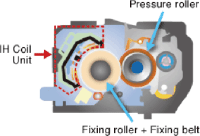 | Laser printers work by fusing toner onto paper to make it “stick”. This fusing process involves using heat to set the toner in place. Konica Minolta has worked to develop new ways of reducing overall power consumption, and has introduced a new fusing technology that reduces power consumption during sleep modes, by shortening the warm-up time. The technology in Konica Minolta’s range of multifunction printers uses Induction Heating (IH) to rapidly fuse the toner (this is the same induction heating used in the new range of induction cook tops). IH efficiently converts electric power to heat, which means that the devices heat up more rapidly. This technology also means that users can enable more aggressive power-save mode times without interrupting users when they are trying to print – reducing power usage even more! |
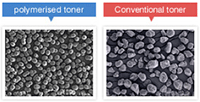 | For greater efficiency, Konica Minolta has developed a Simitri high definition (HD) polymerised toner. Simitri HD toner is actually a biomass – using plant based materials. Biomass is a renewable organic resource made up of biological materials that exclude fossil fuels and generates considerably less C02 than conventional toner. Completely carbon neutral (it doesn’t even release any CO2 when its recycled), the polymerised Simitri HD toner fuses at much lower temperatures, significantly reducing energy consumption. The new toner can also be replaced "on the fly", is fade resistant, has consistently high image quality and reduces paper curling. |
The new range of colour Konica Minolta multifunction printers feature an innovative dynamic Eco Timer which can be programmed on a weekday, date or time basis. It automatically analyses usage and improves settings. For example, it will automatically switch to sleep mode during a recurring lunch break. A special built-in sensor wakes up the device from sleep mode when it senses the user approaching the panel surface and wakes up in just 20 seconds.
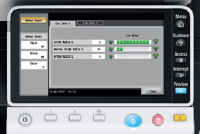 | The new range of colour Konica Minolta multifunction printers also features an Eco Meter. Information on toner and paper savings is displayed on the new Eco Meter, making it easy to assess environmental contributions by device, department and user. |
The plastics used in the construction of devices are traditionally materials that have a significant impact on the environment. To change this, Konica Minolta developed a proprietary recycled PET-based polymer alloy, using a leading-edge chemical processing technology as an environmentally considerate material. The new polymer alloy recycled PET overcomes the disadvantages of the conventional PET plastic, such as fragility, low fire-resistance and difficulties in injection moulding, and has an attractive appearance to make it suitable as an inner material for MFPs. It is also regarded as a promising sustainable plastic as it is a recyclable material that effectively utilises PET waste. In addition, plant-based bioplastic results in lower environmental impact as it uses less petroleum-based resources and emits less CO2 during its lifecycle than petroleum-based plastic. |
Traditional photocopiers use fluorescent or incandescent light bulbs when making copies. These bulbs have mercury in them, which leaches into the natural environment when they end up in landfill.
In the same way that consumers across Australia have been making the switch to energy efficient light bulbs in their homes, Konica Minolta has also been making the switch.
Konica Minolta's new range of multifunction devices use modern LED technology which has no mercury, produces less heat, is cheaper to run and consumes less power.
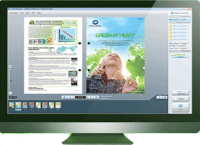 | The new range of colour Konica Minolta multifunction printers features an innovative blank page removal function that also helps prevent paper wastage by detecting and preventing blank pages, found within a set of originals, from being copied or scanned. The new XPS Print Driver provides a detailed and accurate preview function, allowing users to view text placement, hole punch and staple positions. In addition, a real-time scan and copy preview on the control panel allows the user to preview one page at a time, to confirm the position of each document and perform post-scan editing. |
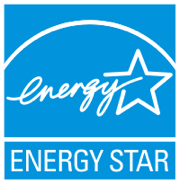 | The need for electricity is an unavoidable requirement in today's office. Generating electricity, however, produces large amounts of greenhouse gases from fossil fuel power stations. One of the best ways to reduce the environmental impact of our energy consumption is simply to use less. TEC is a globally recognised measurement of a device's power consumption. The Energy Star certificate is awarded on the basis of the TEC value. Customers who buy equipment based on the Energy Star certificate can expect reduced running costs and play their part in helping to protect the environment. The lower the TEC rating, the less power the device consumes. Konica Minolta's full range of multifunction printers and printers have very low TEC values. This means that they consume very little electric power – reducing your greenhouse gas emissions and your power bill. |
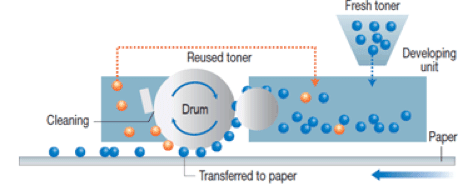 | Konica Minolta's original toner loop mechanism, which collects, circulates and reuses any toner that has not been transferred to the paper, is utilised for almost all monochrome multifunction printers and laser printers. This process realises resource conservation by reducing the normally 5 to 10% of wasted toner to zero. |
 | Konica Minolta's original toner loop mechanism, which collects, circulates and reuses any toner that has not been transferred to the paper, is utilised for almost all monochrome multifunction printers and laser printers. This process realises resource conservation by reducing the normally 5 to 10% of wasted toner to zero. Register here for our Cartridge Collection Program. |

